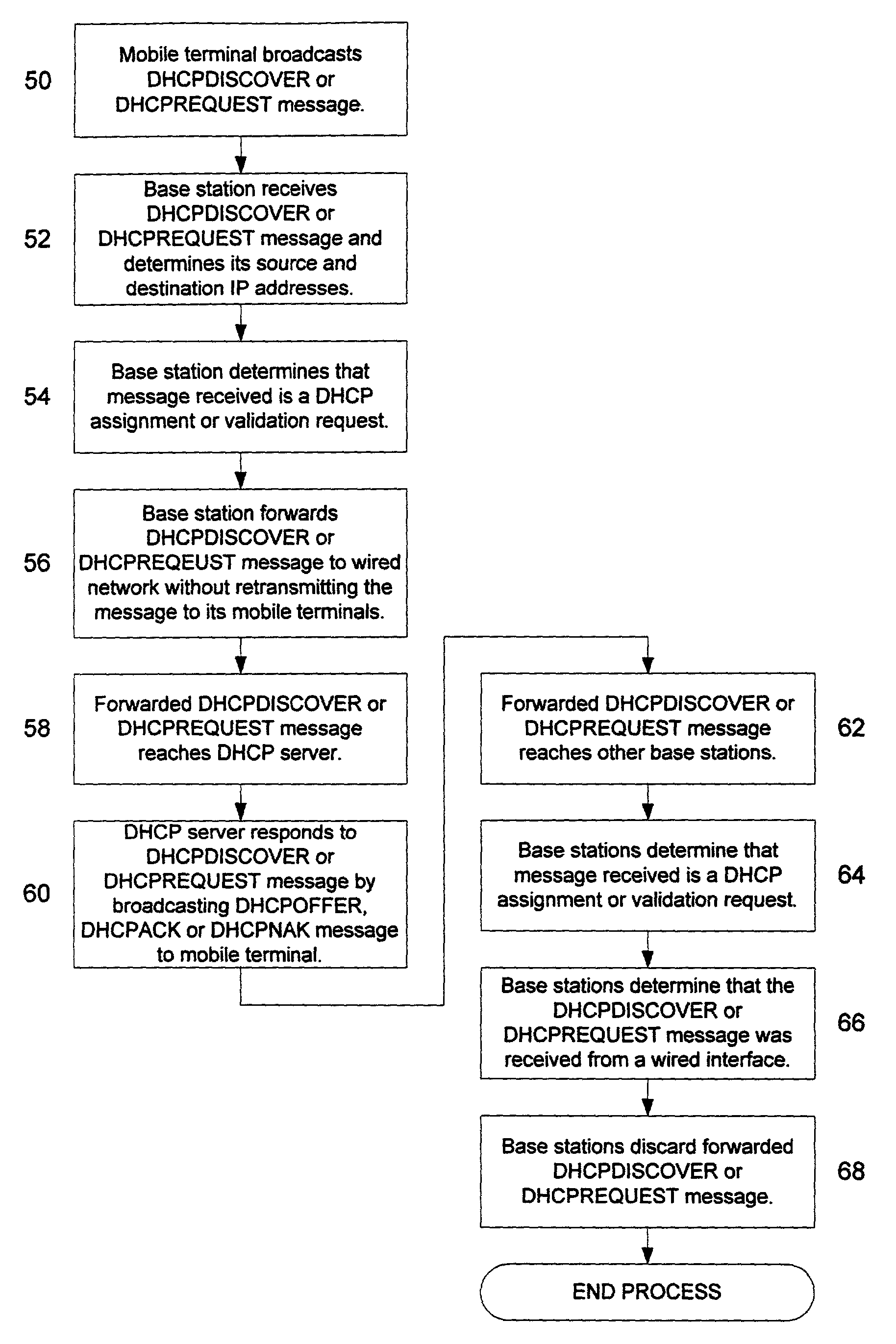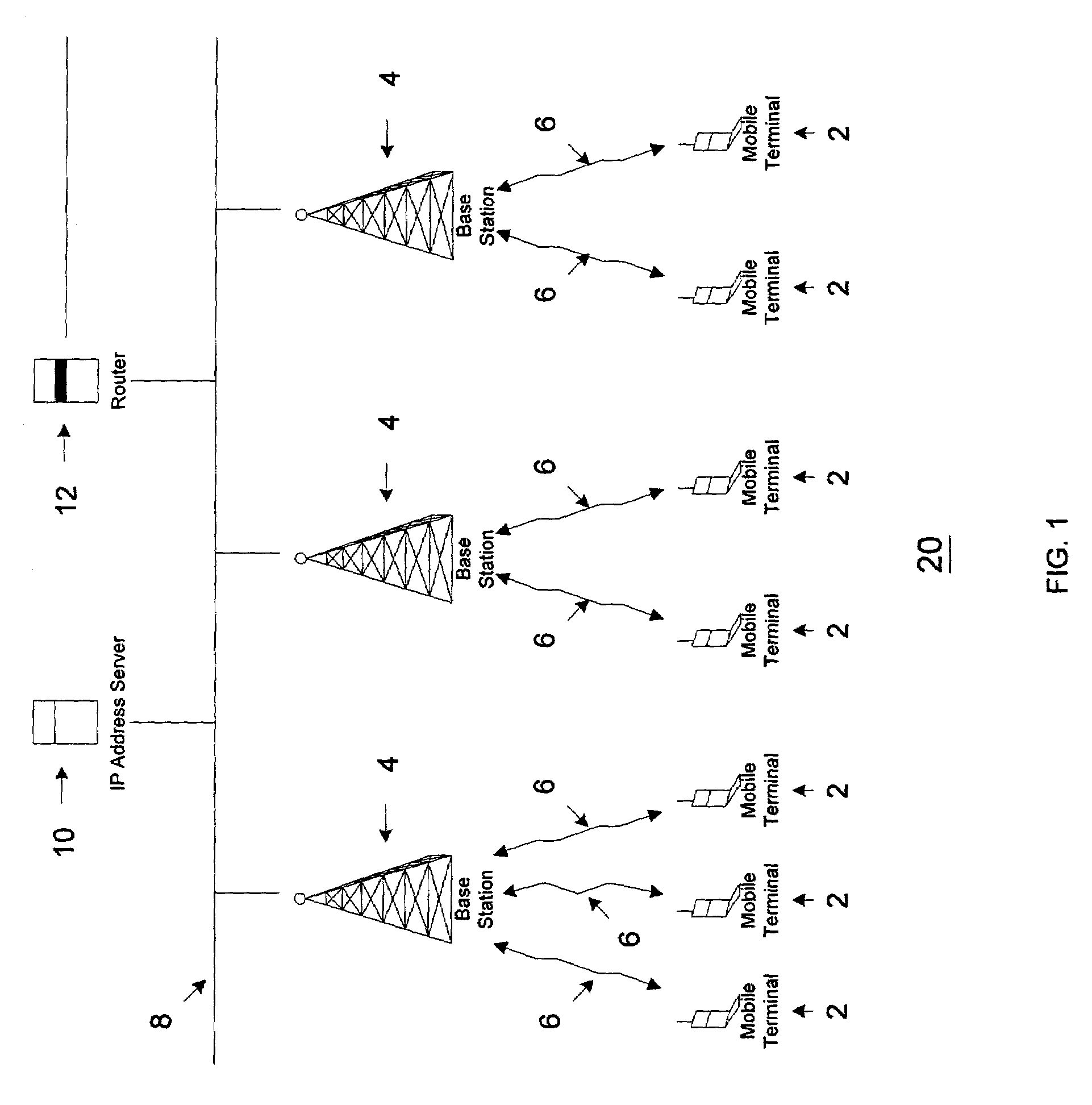[0022]The present invention reduces unnecessary IP network traffic caused by the broadcast of assignment and validation information, and in particular the unnecessary
wireless broadcast of assignment and validation information, by preventing communication of such information to those network devices that are unnecessary recipients of this information. The broadcast of this information, including assignment and validation requests by mobile terminals and response assignment and validation information from IP address servers, is limited to prevent unnecessary transmission of this information to mobile terminals that are known to not require this information. As implemented in wireless IP networks, the present invention prevents the communication of assignment and validation information from mobile terminals and IP address servers to other mobile terminals within the same subnet, except for those mobile terminals that are
broadcasting assignment requests and validation requests. In other words, if a mobile terminal is not requesting an IP address or validating its current IP address, then that mobile terminal will not receive assignment or validation information. In this way, the present invention significantly decreases wireless IP network traffic by blocking the unnecessary transmission of assignment and validation information to mobile terminals.
[0026]By blocking the unnecessary transmission of assignment and validation information, the present invention significantly benefits wireless IP networks. First, the amount of unnecessary
wireless network traffic transmitted to mobile terminals is reduced, thereby increasing the bandwidth to available mobile terminals. Second, the power necessary to communicate information is reduced due to the reduction of transmissions, and the amount of interference caused by unnecessary transmissions to mobile terminals is also decreased. Third, the latency and potential loss of data caused by unnecessary IP network traffic is significantly reduced. Finally, the additional cost necessary to provide bandwidth to compensate for the unnecessary transmissions is reduced.
[0027]In addition to these benefits to the
base station network, the present invention does not require the modification of dynamic IP address assignment protocols. In particular, the only modifications necessary to implement the present invention in a wireless IP network take place at base stations within the wireless IP network. Thus, dynamic IP address assignment protocols essentially “
plug in” to the wireless IP network without modification, and yet the present invention still blocks unnecessary transmission of assignment and validation information to mobile terminals.
[0029]In addition to blocking terminal-to-
server and
server-to-terminal assignment and validation information, the present invention is also able to perform these functions automatically whenever a user migrates from one subnet to another. Thus, unlike known methods for assigning and validating IP address information in wireless IP networks, the present invention prevents a user, such as a mobile terminal, from inadvertently using an invalid IP address within a new subnet. The present invention accomplishes this automatic validation and assignment of IP addresses for new subnets through a mobility
daemon included in the user's driver
software. Here, the mobility
daemon first resets the user's IP address to a null address (typically 0.0.0.0) whenever the user enters a new subnet. By resetting the user's IP address to 0.0.0.0, the present invention prevents the user from using the former IP address in the new subnet until that address is validated within the new IP subnet. This resetting is temporary, however, until the user validates the former IP address from the former subnet or is assigned a new and valid IP address for the new subnet. A mobile
daemon is a background program that runs continuously for the purpose of handling periodic service requests from the mobile terminal.
[0031]As implemented in a mobile terminal for a wireless IP network, the mobility daemon prevents the mobile terminal from using an invalid IP address from a former subnet in a new subnet as the mobile terminal migrates through the wireless IP network. Thus, data communication between a mobile terminal and the wireless IP network is not impaired when a mobile terminal migrates from one subnet to another, and the mobile terminal is able to enjoy full mobility within the IP network without risking loss of its network session. In addition, the operation of the mobility daemon is automatic, and thus the wired network and its associated base stations do not have to include any special
software or instructions to support the handoff of mobile terminals from one subnet to another.
[0033]As a result of these and other embodiments described above, the present invention includes a plurality of IP networks and mobile terminals that may independently benefit to varying degrees according to the present invention and its different embodiments. For instance, one mobile terminal with a mobility daemon and another without a mobility daemon may simultaneously communicate with a wireless IP network that includes server-to-terminal and / or terminal-to-server blocking. Both of these mobile terminals will enjoy the benefit of assignment and validation information blocking although one mobile terminal automatically validates and requests assignment of their IP address, whereas the other does not. Similarly, a mobile terminal with a mobility daemon may migrate from a subnet with terminal-to-server blocking and / or server-to-terminal blocking to a subnet without terminal-to-server blocking or server-to-terminal blocking. The mobile terminal will benefit from the mobility daemon in both networks although one network includes some form of assignment and validation information blocking whereas the other does not. So long as a mobile terminal includes a mobility daemon, or the IP network communicating with the mobile terminal includes terminal-to-server or server-to-terminal blocking, then the mobile terminal will benefit from the present invention. Thus, terminal-to-server blocking, server-to-terminal blocking and the mobility daemon provide both independent and collective benefits to mobile terminals according to the present invention.
 Login to View More
Login to View More  Login to View More
Login to View More 


